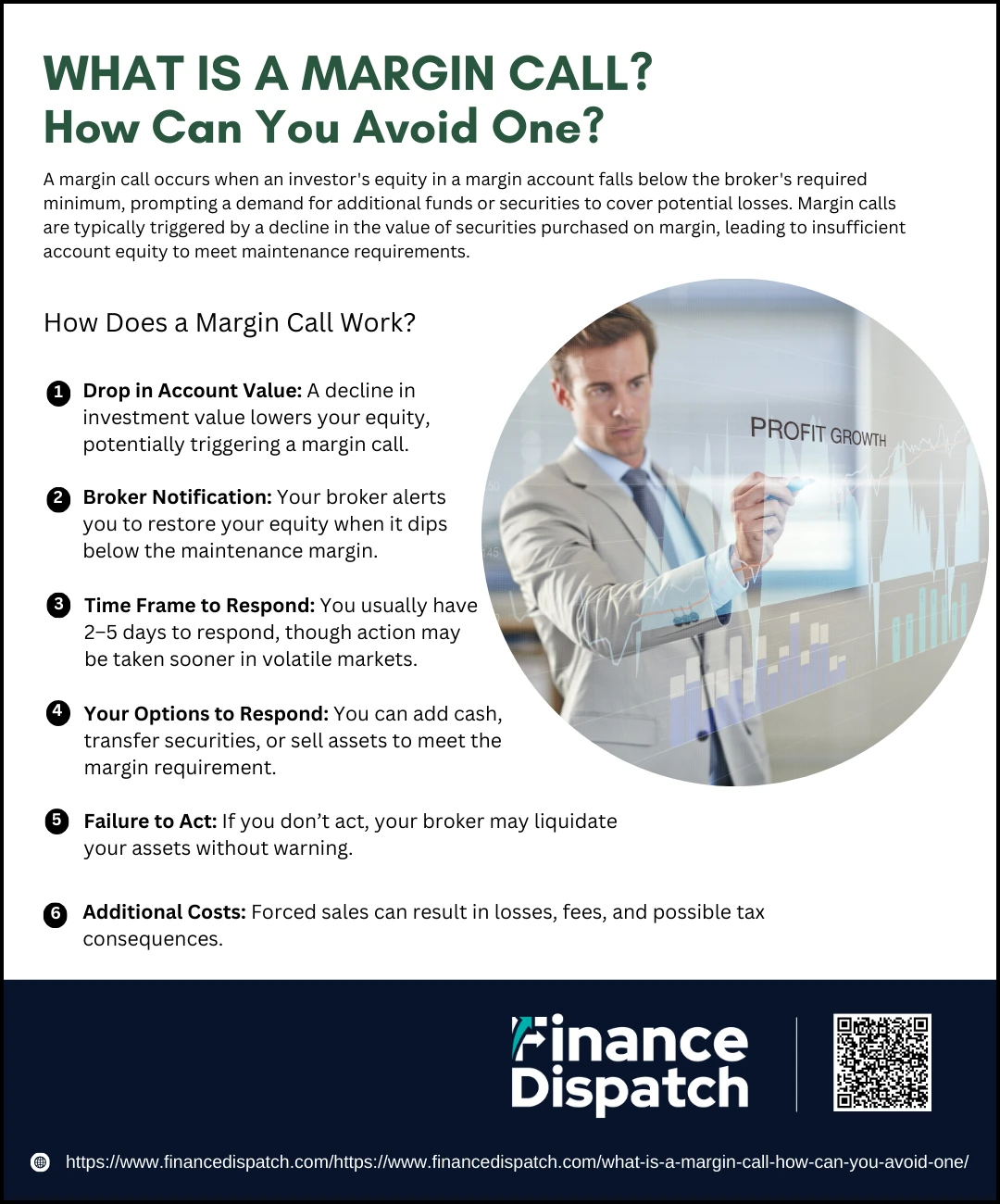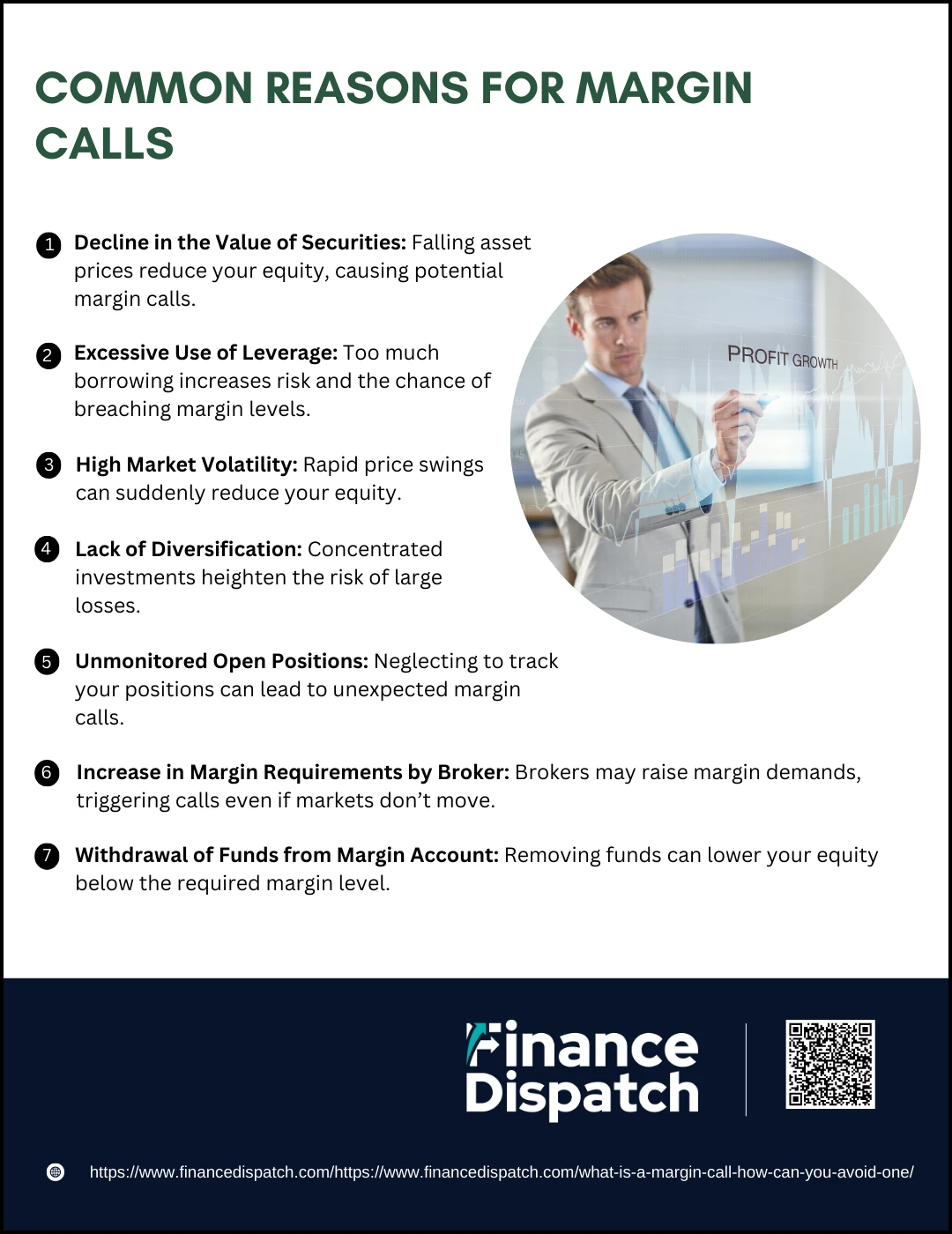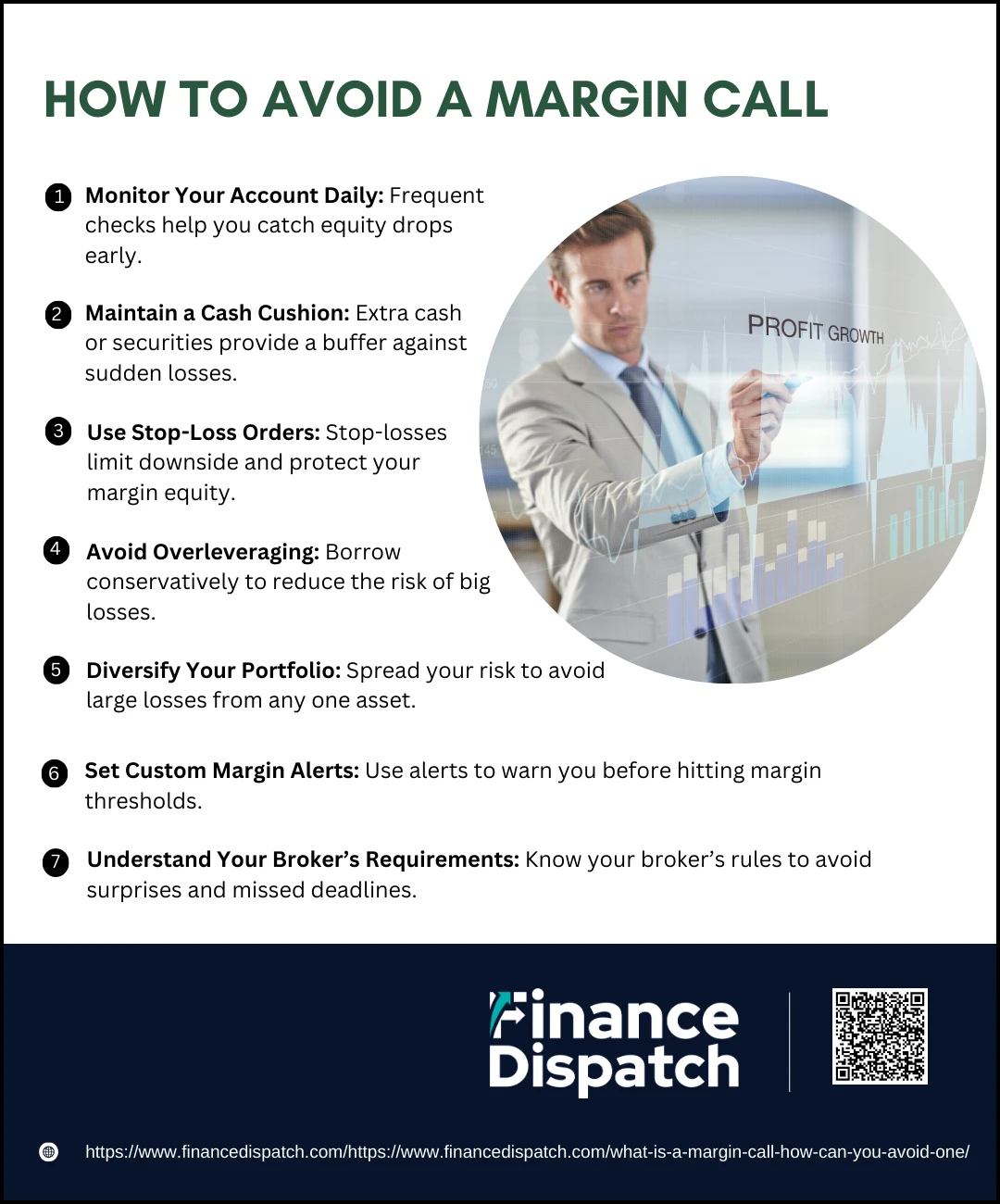If you’re venturing into the world of margin trading, understanding margin calls isn’t just useful—it’s essential. A margin call is a broker’s way of saying, “Your account needs more money, or we’ll start selling your assets.” It’s a signal that your investments, purchased partly with borrowed funds, have declined in value enough to put your account at risk. While the idea of borrowing to invest can be tempting—offering the chance to amplify gains—it also increases the potential for losses. And when things move in the wrong direction, a margin call can force you into selling at the worst possible time. In this article, we’ll break down exactly what a margin call is, how it works, and more importantly, how you can avoid one.
What is a Margin Call?
A margin call occurs when the value of your margin account falls below the minimum required level set by your broker, known as the maintenance margin. When you buy securities using a combination of your own money and borrowed funds—commonly referred to as trading on margin—you’re required to maintain a certain percentage of equity in your account. If the market value of your investments drops significantly, your equity shrinks. Once it dips below the threshold, your broker will issue a margin call, demanding that you deposit more cash or marginable securities to restore the account’s balance. If you fail to act quickly, your broker has the right to sell off your assets—sometimes without your permission—to bring the account back into compliance.
 How Does a Margin Call Work?
How Does a Margin Call Work?
A margin call is a broker’s way of protecting itself when your account no longer has enough equity to support the borrowed funds used in margin trading. When the value of your investments falls, so does your equity. If it dips below the minimum threshold, your broker will require you to add more funds or risk losing your positions. Here’s a detailed look at how the process works from start to finish:
1. Drop in Account Value
The first step toward a margin call is a decline in the market value of the securities in your margin account. Since you’ve purchased these using both your funds and borrowed money, any drop in value impacts your equity proportion. If the drop is sharp enough, your equity can fall below the maintenance margin level required by your broker—often 25% to 35%—prompting a margin call.
2. Broker Notification
When your account equity breaches the required maintenance margin, your broker issues a margin call. This can come in the form of an automated email, text, or an alert through your trading platform. The notice serves as an urgent request to either deposit more assets or reduce the amount you’ve borrowed by selling off some of your investments.
3. Time Frame to Respond
Most brokers give you a short window to correct the imbalance—typically between 2 to 5 business days. However, in highly volatile markets or under specific brokerage agreements, the broker might act instantly. This means the time to respond can vary, and sometimes you won’t have the luxury of waiting at all.
4. Your Options to Respond
You have several ways to resolve a margin call:
- Deposit cash to immediately raise your account equity.
- Transfer marginable securities from another account that meet the broker’s requirements.
- Sell off positions in the account to repay part of your loan and reduce the margin requirement.
- Use a combination of cash and securities to restore balance.
5. Failure to Act
If you don’t respond to the margin call within the allowed time frame, your broker has the right to sell any or all of your investments to cover the margin deficiency. This process is called forced liquidation and may happen without your consent or prior notice, depending on your brokerage agreement. The sale might also occur at an unfavorable price, increasing your losses.
6. Additional Costs
Beyond losing control over your assets, you might also face financial penalties. These include transaction fees, interest on the borrowed funds, and potential tax implications from forced sales. Plus, any realized losses from selling assets at a low point fall entirely on your shoulders—not the broker’s.
 Common Reasons for Margin Calls
Common Reasons for Margin Calls
Margin calls don’t come out of nowhere—they’re usually the result of specific events or oversights in your trading strategy. When you use borrowed funds to invest, your account becomes more sensitive to market fluctuations and trading behavior. Even small changes can tip the balance and trigger a margin call. Below are the most common reasons traders and investors face them:
1. Decline in the Value of Securities
The most common trigger for a margin call is a drop in the market value of the securities in your margin account. Since your borrowed funds remain constant, any decrease in asset value reduces your equity, potentially pushing it below the required maintenance margin.
2. Excessive Use of Leverage
Using too much borrowed money increases your exposure to risk. While leverage can amplify gains, it also magnifies losses. If the market turns against your position, even slightly, a highly leveraged account can breach margin requirements very quickly.
3. High Market Volatility
Sudden price swings in volatile markets can rapidly change the value of your investments. This unpredictability can lead to a margin call, especially if you’re holding positions that are highly sensitive to news or earnings reports.
4. Lack of Diversification
Concentrating your investments in a single stock or sector makes your account more vulnerable to sharp losses. A drop in that one area can significantly impact your equity and trigger a margin call much faster than in a diversified portfolio.
5. Unmonitored Open Positions
Not keeping a close eye on your positions means you might not notice when your equity starts to fall. Without regular monitoring, you risk missing early warning signs and can be caught off guard when a margin call arrives.
6. Increase in Margin Requirements by Broker
Brokers can change margin requirements based on market conditions, the risk level of a security, or your own trading history. If your account doesn’t meet the new margin requirements, it can result in an immediate margin call—even if the market hasn’t moved against you.
7. Withdrawal of Funds from Margin Account
Removing cash or securities from your margin account reduces your available equity. If the withdrawal drops your equity below the required level, a margin call will be triggered—even if the market hasn’t changed.
Consequences of Ignoring a Margin Call
Ignoring a margin call can lead to serious financial consequences, especially when you’re trading with borrowed money. Margin calls are your broker’s way of saying your account has dipped below the safe equity threshold. If you don’t respond quickly, your broker may take matters into their own hands—often resulting in actions that are costly and out of your control. Here’s what can happen when a margin call is ignored:
1. Forced Liquidation of Assets: Your broker can sell some or all of your securities without your consent to bring the account back into compliance with margin requirements.
2. Realized Losses: Positions may be sold at unfavorable prices, especially in a falling market, locking in losses that you otherwise might have avoided.
3. Loss of Trading Privileges: Your broker may restrict your ability to place new trades or even suspend your margin account altogether.
4. Additional Fees and Interest Charges: You may incur commissions on forced trades and ongoing interest on the borrowed funds, further compounding your losses.
5. Damage to Broker Relationship: Repeated margin call violations or failure to maintain adequate equity can hurt your standing with the brokerage, potentially affecting future borrowing or margin privileges.
6. Total Account Wipeout: In extreme cases, ignoring a margin call can result in the complete loss of your invested capital, especially if markets continue to move against you.
 How to Avoid a Margin Call
How to Avoid a Margin Call
Trading on margin can be tempting because it allows you to amplify your buying power. But with that power comes increased responsibility—and risk. A margin call is one of the most stressful situations for any trader or investor, often forcing you to act quickly or face financial losses. The good news? Margin calls are often preventable. With the right strategy and mindset, you can manage your margin account wisely and avoid unnecessary calls from your broker. Here’s how:
1. Monitor Your Account Daily
Keeping a regular eye on your account balance, margin level, and equity ensures you’re not caught off guard. Markets can move fast, and checking your account daily gives you the chance to react before your equity falls below the required threshold.
2. Maintain a Cash Cushion
Don’t operate right on the edge of your margin limit. Keeping extra cash or marginable securities in your account gives you a safety net. That way, if the value of your holdings drops unexpectedly, you’re less likely to hit the margin minimum.
3. Use Stop-Loss Orders
Stop-loss and trailing stop orders are essential tools for risk management. They help cap your losses by automatically selling a position when it falls below a certain price. This not only protects your portfolio but also helps maintain your equity above the required margin.
4. Avoid Overleveraging
Using too much borrowed money means small market movements can lead to big losses. Be conservative with your leverage. Just because you can borrow a large amount doesn’t mean you should. Only borrow what you can comfortably support with your available equity.
5. Diversify Your Portfolio
A diversified portfolio spreads your risk across multiple assets or sectors. This helps reduce the impact of a single asset’s poor performance, which might otherwise drag down your overall account value and trigger a margin call.
6. Set Custom Margin Alerts
Most online brokers offer tools that let you create alerts when your account approaches certain equity levels. Setting these alerts can give you an early warning system, allowing you to act before things become critical.
7. Understand Your Broker’s Requirements
Every brokerage firm has its own rules regarding initial and maintenance margin requirements. Make sure you read and understand the fine print of your margin agreement so you’re never surprised by how much equity you need to maintain or how quickly you need to respond to a margin call.
Margin Call vs. Maintenance Margin: Know the Difference
When you’re trading on margin, two key concepts you’ll encounter are the margin call and the maintenance margin. While they’re closely related, they serve very different purposes. The maintenance margin is a requirement set by your broker—the minimum amount of equity you must maintain in your account to keep your positions open. A margin call, on the other hand, is what happens when your equity drops below that required level. Understanding how these two work together is essential for managing your risk and avoiding costly surprises. Here’s a comparison to help you clearly distinguish the two:
| Feature | Maintenance Margin | Margin Call |
| Definition | The minimum amount of equity you must maintain in your account | A broker’s demand for more funds when your equity falls below the required level |
| Purpose | To ensure you have enough equity to cover potential losses | To restore your account balance to meet margin requirements |
| When It Applies | Constantly monitored while you hold positions | Triggered only when equity drops below the maintenance margin |
| Set By | Broker or regulation (e.g., FINRA requires at least 25%) | Triggered by broker based on account equity status |
| Trader Action Required | No action needed if equity stays above the limit | Action is required: deposit cash/securities or liquidate positions |
| Impact on Trading | None, as long as you’re in compliance | Can restrict new trades and lead to forced liquidation if not resolved |
| Frequency | Always in effect | Happens only when your equity drops below the threshold |
Conclusion
Margin trading can be a powerful tool for amplifying returns, but it comes with significant risks—none more urgent than the margin call. Understanding what triggers a margin call, how it works, and the role of maintenance margin can help you manage your account with greater confidence and control. By staying informed, maintaining a cushion of equity, and using smart risk management strategies, you can avoid the stress and financial consequences that come with margin calls. Ultimately, the key to successful margin trading is not just maximizing gains, but also minimizing risk—and that starts with knowing the rules of the game.



